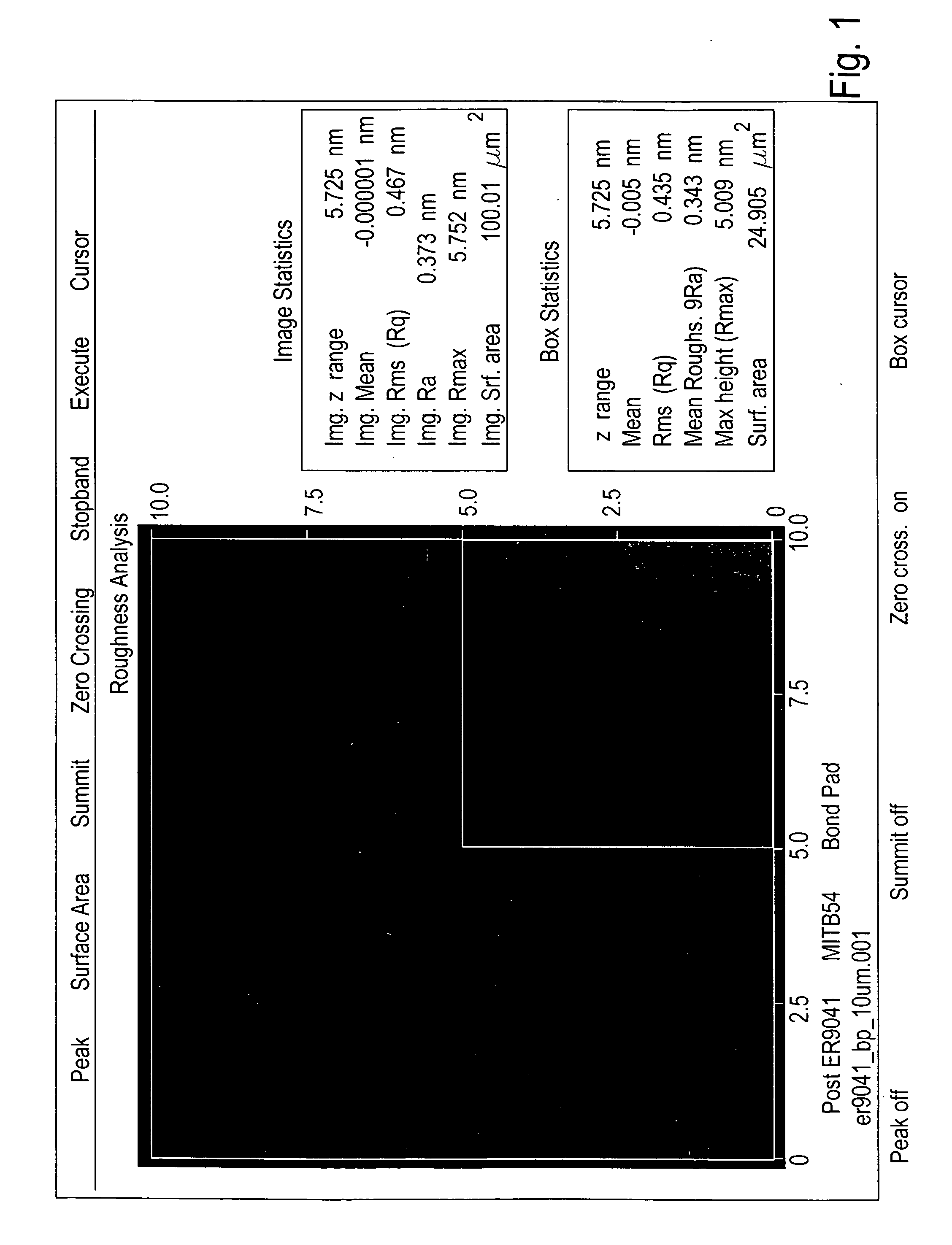Copper polishing slurry
- Summary
- Abstract
- Description
- Claims
- Application Information
AI Technical Summary
Benefits of technology
Problems solved by technology
Method used
Image
Examples
examples
[0033]The following data was obtained on 8″ copper blanket films. The polishing was carried out on a Mirra polisher (Applied Materials, Inc.) with IC1010 pads which were conditioned with either an ABT, 3M or Kinik conditioner. Table 1 below shows the conditions under which the following data was collected.
TABLE 1Platen (RPM)Head (RPM)Inner Tube (psi)Retaining Ring (psi)Membrane (psi)Slurry Flow (mL / min)3 psi DF1131194.14.732002 psi DF1131192.83.522001.5 psi DF 11311922.31.5200
[0034]Two initial slurry compositions were prepared, one with the water-soluble composition, and one without. As shown in Table 2, the passive etch rate of the slurry remains very low with or without the water-soluble polymer. In fact, the passive etch rate of the slurry is lessened by the addition of the polymer. As previously discussed, a large or increased passive etch rate can lead to dishing of the copper trenches and vias on the wafer.
TABLE 2EtchingEtchingEtch RateTrial #SlurryTemperature (° C.)Time (sec...
examples 1-4
[0036]The data in Table 4 below shows the removal rate of copper at various concentrations of the water-soluble polymer. Example compositions 1-4 all had varying concentrations of components, but all contained colloidal silica abrasives, organic acids, corrosion inhibitors, and pH adjusters.
[0037]As can seen from this data, the removal rate of copper is dramatically enhanced upon the addition of the water-soluble polymer.
TABLE 4Example 1 Cu RR (Å / min)Down Force (psi)0 ppm100 ppm3656110174 227976337 1.518924474Example 2 Cu RR (Å / min)Down Force (psi)0 ppm50 ppm100 ppm200 ppm1000 ppm371389897977194492019Down Force (psi)0 ppm100 ppmExample 3 Cu RR (Å / min)363728147240314917 1.531853884Example 4 Cu RR (Å / min)367837941233614330 1.522112857
examples 5-9
[0038]Table 5 shows the effect of varying the percentages of various components of the slurry on the copper removal rate, dishing, and erosion defects. As can be seen, the inclusion of a copper chelating agent and soft particles reduces topography for patterned wafers. At a down force of 3 p.s.i., slurries without the soft particles may exhibit better copper removal rates and similar WINWU. At 1.2 p.s.i., however, slurry #2, which includes the chelating agent and the soft particles, exhibits significantly improved dishing and erosion characteristics, while maintaining favorable copper removal rates and WINWU, when compared to slurries without those components.
TABLE 5Example No.56789CompositionColloidal silica (%)0.50.50.50.50.5Organic acid (%)1.01.01.01.01.0Corrosion inhibitor, I (%)0.20.20.20.20.2Polymer (ppm)100100100100100Corrosion inhibitor, II (ppm)3030303030Copper Chelator (ppm)0505075100Soft particles (ppm)070000H2O2 (%)0.80.80.80.80.8pH77777Cu RR 3 psi, Å / min9034812186058388...
PUM
 Login to View More
Login to View More Abstract
Description
Claims
Application Information
 Login to View More
Login to View More - R&D
- Intellectual Property
- Life Sciences
- Materials
- Tech Scout
- Unparalleled Data Quality
- Higher Quality Content
- 60% Fewer Hallucinations
Browse by: Latest US Patents, China's latest patents, Technical Efficacy Thesaurus, Application Domain, Technology Topic, Popular Technical Reports.
© 2025 PatSnap. All rights reserved.Legal|Privacy policy|Modern Slavery Act Transparency Statement|Sitemap|About US| Contact US: help@patsnap.com

